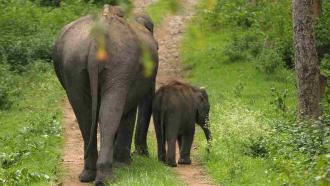
Do animals have consciousness and free will? Are they capable of making informed decisions or do they merely act out based on instinct?
A unique interaction and discussion took place at the National Institute of Advanced Studies (NIAS), Bangalore, on 14th of February on “Animal Minds”. The session consisted of a philosophical enquiry into the minds or the lack thereof, of non-human animals.
Prof. Anindya Sinha, a primatologist from NIAS, Mr. Nitesh Anchan, a doctoral scholar and Mr. Nishant M Srinivasaiah, also a doctoral scholar, presented varied approaches with which they address this question in philosophy though their respective research.
Mr. Anchan approached the question of whether animals have minds through the lens of history. Starting as far back as the 384 BC with Aristotle’s ideas on the subject of mind which consisted of a hierarchy with humans at the top of the list, and animals at the bottom, to Darwin’s ideas on the subject: the difference between humans and non-human animals was only one of degree and not of type.
Coming from the other side of the timeline, Prof. Sinha presented his work on Bonnet Macaques. He expressed his view that the study of behaviour was the only means we possess to empirically analyse the existence of an animal mind. He recounted the experiments conducted in the field which recorded a novel behaviour in the juvenile Macaques. The animals showed higher cognitive abilities by interacting with humans through vocalisations and hand gestures, to ask for food.
Prof. Sinha argued that the animal gestures were referential and intentional, specifically to attract the humans attention, as the Macaque only extended its hand when it made eye contact with the human. He went on to say that cognition is embedded in behaviour directly and that such a combination of different kinds of signals could be an early cognitive precursor for human language.
Mr. Srinivasaiah who works on wild Asian Elephants also, added to the arguments that Prof. Sinha was making by recounting his experiences in the field. He made a case for how interaction with humans is making elephants adapt to novel challenges in their surroundings through conscious decision making. He presented results of how information is passed through the only male groups formed in elephants, which is a recent phenomenon. The researchers think that these male groups are formed so that the younger males can benefit from the knowledge of older males while navigating through an increasingly human dominated landscape. He provided an example of how younger males that associate with crop raiding older elephants are more likely to raid fields later in their lives, when compared to younger males associating with older males that do not engage in crop raiding behaviour.
Or how upon encountering a novel object in their surroundings, namely a camera trap equipped with a flash, the elephants were seen to gauge whether it posed a threat and when they were certain it did not, they still came back to look for it while passing by. These findings suggested that they were aware of the changes in their surroundings, and were making decisions and changing their behaviour appropriately to tackle them.
When the discussion was left open to the audience many questions were added to the interaction showcasing exactly how deep this question is. Starting from what would be the distinction between a human and a non-human to whether we should look at the evolution of behaviour through the lens of Darwinism or Lamarckism were touched upon.
The NIAS Wednesday Discussion meeting, of which this discussion was a part, are held on every Wednesday as part of a larger outreach program. The faculty and students of the Institute meet every Wednesday morning for academic discussions after a lecture usually delivered by one of its members.






